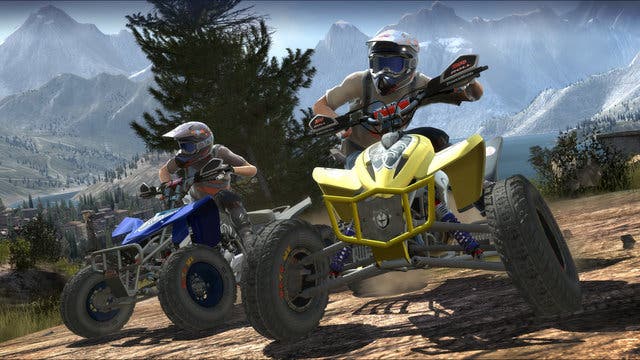Pure
Driven.
At first, much of your effort is spent on things like not crashing every time, or taking an effective racing line that doesn't result in falling off the side of a hill into oblivion. The excellent branching track design feels like a bit of a double-edged sword while you're learning the ropes. With no set route to follow, there's an inherent panic over having to make split-second decisions and then make equally quick jump/trick choices. But with the Race courses clocking in at around 90 seconds a lap, the familiarity of looping the same terrain three times in quick succession per race soon eradicates the initial sense of bumbling uncertainty. Each track feels like a puzzle to explore. There's no way you'll get by through racing grit alone in the first instance.
In the game's other modes, the trick/race emphasis sits either side of Race mode. In Sprint mode, the emphasis is on pure wheel-to-wheel racing. Described as the game's 'Espresso shot', each track is much shorter than the Race equivalents, with each lap clocking in at just 40 seconds. Tracks feature only a couple of jumps, so there's much less of a chance to 'boost surf' around the course, and more focus on keeping on the track and the racing line. A quick blast was light relief, sacrificing some of the depth and trickery of Race mode for a more frantic, more traditional take on quad-bike racing. As an introduction to the basic handling, Sprint runs are arguably your best first port of call.
Freestyle mode, meanwhile, takes a more fantastical approach entirely. The overriding goal has little to do with being first past the post. This time it's important to get the best score, and doing so means staying in the race by not allowing your ride to run out of gas. Pulling off tricks is the top priority, with a proportionally greater score awarded to fancier tricks. Chaining tricks together via the linker timer is the key, but doing so is an art in itself. Do you risk draining gas by using your boost and make a better jump, or just play it safe? Aiding you in your quest for points and more gas are four types of pick-up: one raises boost level, one multiplies score, one tops up fuel, another allows you to do more advanced signature tricks.
By far the trickiest mode with which to get to grips, it's even more crucial in Freestyle to learn the course layout and learn the best route to scoop up those precious pickups. More so than in Race mode, you'll find yourself tricking off every little bump in the road - even fairly insignificant ramps can be mined for a trick opportunity, allowing you to amp up your boost bar fairly quickly. But to really get good, it's essential to have a grasp of the trick mechanics in the first place. Definitely not one into which you should dive straight away.

In total, the game's World Tour mode is comprised of 50 events, with 12 tracks per mode over six locations, making 36 tracks altogether. You can expect a fairly diverse set of locations, including Italy, New Mexico, Wyoming and California, with more yet to be revealed. Meanwhile, there are six characters (plus one unlockable), and a bike-creation system that allows for 70-100,000 possible permutations. For the purposes of the demo we didn't really check out the customisation element, but it's possible to tinker with both performance and the overall look of the quad bike.
With features locked down, Black Rock is also keen to stress that PS3 fans can expect the game to look identical to the 360 version - in other words, a solid 30 frames-per-second, massive 20km draw distance and exceptionally impressive levels of details throughout. Will Pure be the first game since Burnout Paradise to live up to that billing? Our Face-Off workbench is ready and waiting. Multiplayer support will also be identical, Black Rock tells us, with 16-player online play promising the ability to do anything in the offline game in multiplayer, which is nice. And with review code set to wing its way to us in the very near future, you can check back soon to see if Pure delivers on its promise.

